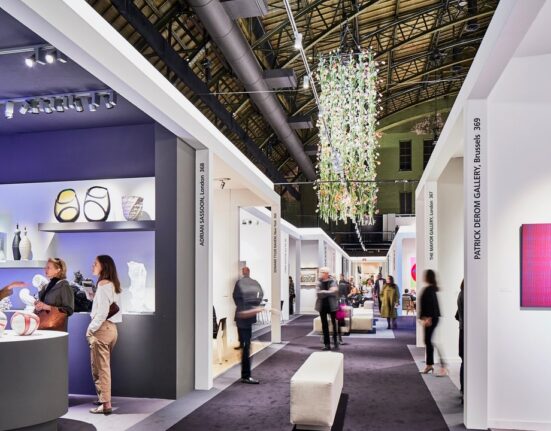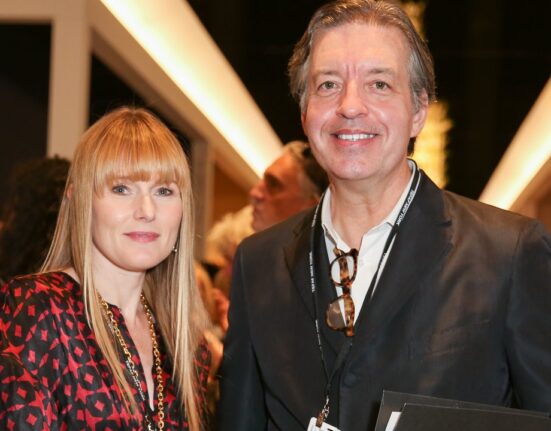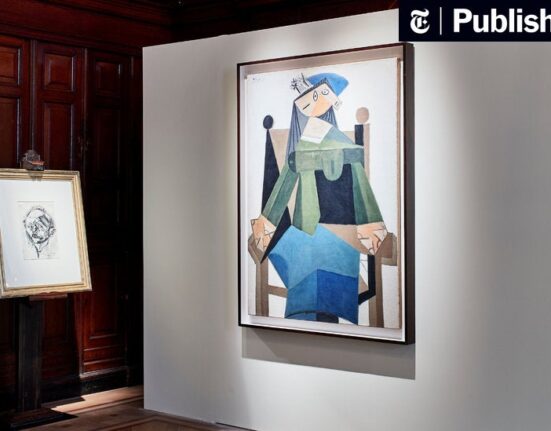MAASTRICHT, the Netherlands — The European Fine Art Fair, known as TEFAF, was the international art market’s first major casualty of the coronavirus pandemic. It’s also been one of the last to return to relative normalcy.
On Friday, V.I.P.s attended the preview of the first in-person TEFAF Maastricht since March 2020, when the fair had to close early because an exhibitor tested positive for the virus.
The long-established event, regarded as the world’s pre-eminent fair for art, objects and furniture ranging back through the centuries, was canceled in 2021 and postponed this year by three months to an unfamiliar summer slot.
“It’s good to be back,” said Sam Fogg, a London-based dealer in medieval art, one of several exhibitors who contracted the virus at the 2020 edition. Fogg spent more than six weeks in the hospital after that ill-fated event. “I think I caught it off an Italian dealer and then gave it to my staff,” he added. “But I’m fully recovered now.”
Fogg said he was appreciative that the fair, which is managed by a nonprofit foundation of dealers, had managed to reschedule its 35th edition just three months after its original date. The event was shortened to six from 11 days, and the exhibitor list was cut by about 14 percent, to 242 from 280. TEFAF is scheduled to return to its usual March slot next year, rather than squeezing in between the Art Basel fair in Switzerland, a similarly postponed edition of BRAFA in Brussels and Masterpiece in London, as it did this year.
“It’s a busy time,” Fogg said. “But we’ve sold a few things. It’s not a bad start.”
Exhibitors’ sense of a return to business as usual has been tempered by an awareness that the pandemic has profoundly changed their business. A new wave of younger, Instagram-savvy buyers has entered the market, deepening demand for contemporary art, particularly by young painters. Advances in digital technology at the major auction houses have made many wealthy collectors comfortable with spending large sums on 21st century works they haven’t seen in real life. Less fashionable older pieces, whose authenticity, condition and provenance need checking, are a harder sell online.
“They have to be seen in person,” said the London-based dealer Stuart Lochhead, adding that representatives from a major American museum had visited his TEFAF booth to inspect a rare 1530s French alabaster sculpture of the Virgin and Child. He declined to name the museum, but said it bought the work for a seven-figure price.
The presence of curators, conservators and donors from museums in Europe and the United States is a key draw for dealers to exhibit at TEFAF Maastricht. Representatives from some 20 U.S.-based institutions, including the Metropolitan Museum of Art, the National Gallery of Art and the Art Institute of Chicago, attended the fair, according to the TEFAF media office.
“American museums are primed to buy,” said the New York-based dealer Nicholas Hall, who specializes in high-end old master pictures. Hall was showing a superb “Virgin and Child With Saints Cecilia and Ursula,” from about 1495, by the Venetian painter Vittore Carpaccio. Consigned for sale from a private collection in the United States, it had been reserved by another American collector before the fair, Hall said, priced between $10 million and $15 million.
Since TEFAF’s equivalent sister fair in New York in the fall has been scrapped (though it still holds its spring fair for modern and contemporary works), TEFAF Maastricht was now “the one opportunity for dealers to put together a group of pictures to rival the auction houses’ old master sales,” Hall said.
Certainly Hall’s Carpaccio, an Artemisia Gentileschi self-portrait as Cleopatra with Heim of Basel at around $8 million and the late Goya canvas “St. Paul,” with the London-based Stair Sainty at $6 million seemed to represent a more impressive offering than Sotheby’s and Christie’s thin old master auctions in London in July.
Unlike the V.I.P. crowd at contemporary fairs like Art Basel or Frieze, TEFAF’s well-heeled clientele tends to be predominantly northern European, white, male and middle-aged, without a designer sneaker in sight. Nonetheless, it does give the less fashionable end of the trade a chance to find buyers for exceptional pieces that can’t be sold online.
De Wit, a firm based in Mechelen, Belgium, specializing in restoring and trading tapestries, was offering a spectacular early 16th century Flemish panel woven with exotic animals in a walled garden. Formerly owned by Prince Sadruddin Aga Khan, and with vividly preserved colors, this was priced at around $500,000, a fraction of its value in the 16th or even the 19th century, when inflation is factored in.
Or there was the equally spectacular, recently rediscovered 1697 silver tankard by the Transylvanian goldsmith Sebastian Hann the Elder that in the 1910s had been in the collection of Baroness Betty de Rothschild. Sumptuously decorated with mythological scenes, this was priced at around $400,000 at the booth of the German exhibitor Senger Bamberg.
“When people walk around here, they realize paying $3.5 million for a work by a young female artist isn’t such a great investment,” said the New York-based dealer Christophe van de Weghe, an exhibitor in TEFAF’s modern and contemporary section, “We’ll see what happens to these artists in 50 years,” van de Weghe added.
Prices of $500,000 and upward for paintings by young Instagram sensations have become routine at today’s contemporary art auctions; TEFAF Maastricht is the ultimate shop window for centuries-old rarities that can be bought for the same kind of money. The continuing challenge for TEFAF and its exhibitors is to find a new generation of buyers to notice and care.







